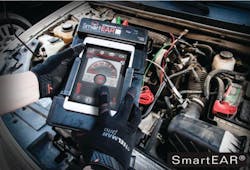Tool Q&A: Performing power steering maintenance and repairs
Power steering is a great convenience in vehicles, and has made vehicle handling much smoother since the days before it was available. (The rack-and-pinion type power steering is by far the most popular.) But when these systems fail, attempting to turn the wheel can be even harder than a vehicle not equipped with power steering. When it happens, customers definitely want it fixed. No one likes to fight to turn the wheel.
Q: The pump is not whining and it looks like there is fluid moving in the reservoir, so how do I tell for sure if its bad?
A: A power steering pump may look and sound like its operational from a quick visual, but may be weak to the point where there is not enough fluid pressure to get the desired results. The first thing you always want to do is check the drive belt and make sure it is not loose or slipping. If the belt is tight, then it’s time to dig a little deeper. You need to check the actual pressure and compare it to the factory specs in your service information.
For this step, you will need a power steering pressure gauge such as the Matco Tools PST22A Power Steering Pressure Kit, and the Star Products Power Steering and Rack Tester. These kits come with a pressure gauge and multiple adapters to hook up to your power steering and see the systems pressure. They are easy to use, and are quick to set up. The multiple adapters help fit almost any make and model.
For heavy duty power steering systems, there is the OTC 5079 Heavy Duty Power Steering Pump Analyzer. If you hook it up inline, it can help quickly isolate problems, and can handle from one to 10 gallons of fluid flow.
Q: Are power steering flushes really just wallet flushes, or is there any good to them?
A: Depending on the manufacturer, power steering flushes may be recommended for preventive maintenance. General Motors recommends flushing the power steering system every 50,000 miles. There are some good to flushing power steering systems. Like all fluids, power steering fluid breaks down after time and use. Eventually you can develop leaks at the seals and fittings as the additives in the fluid deplete. If you have customers who like to keep things in peak condition, then you may want to consider power steering flushes. Also, whenever a steering pump or a hydro-boost unit fails, its good practice to flush the steering system, in case any debris contaminated the fluid.
There are a couple ways of doing a flush. One is to use a pneumatic vacuum pump, like the MityVac MV7430, and suck out the reservoir, add new fluid, turn the wheel left to right about 10 times, then repeat the process multiple times to get as much fluid exchanged as you can. This method, though, does not guarantee a full flush and it can be time-consuming. If you start seeing a lot of flushes in your shop, you may want to invest in a fluid exchange machine. These machines are hooked up in line with the power steering hoses and exchange out the fluid.
Some machines available include the Qwik Draw Power Steering Flush Machine by Link New Tech and the SteerClean 1000 Power Steering Fluid Exchanger by Motor Vac. A great option, too, is the Snap-On MFX HD35 Automatic Transmission and Power Steering Fluid Exchanger, since it can flush both transmissions and power steering systems. This unit can also can switch fluid flow so you don’t have to change hoses.
Q: I am trying to pinpoint a noise, and I am suspecting the rack bushings. How can I be sure?
A: If you do a lot of suspension and steering work, then a wise investment would be a chassis ear. This tool will become your best friend. The tool is made by JS Products and comes in a wireless version. It has clamp-on sensors that you hook up to multiple points in the suspension, and a receiver which the sensors transmit to. You then take the vehicle for a test drive and try to duplicate the noise. Then, while using this receiver, you can choose the different sensor transmissions and find which one is near the noise you are hearing.
Q: Any tips for after the steering rack is replaced?
A: Alignment after replacing a steering rack is crucial. Improper toe can eat through tires. Alignment machines used to be very time-consuming to set up, but the newer machines have streamlined this. Systems like the HawkEye from Hunter, and the V3D Arago by John Bean are great examples. Using digital cameras and sensors, they are able to calculate the measurements. This takes out the entire process of having to raise the car, turn the wheels multiple times, lower the car, etc. Its quick and painless and gets you onto the next thing.
Another thing to remember in newer vehicles is resetting sensors. After doing a steering rack and alignment, you may need to recalibrate sensors like the yaw sensor or the steering angle sensor. These can require either a step-by-step process, or be reset by a scan tool. Many aftermarket scan tools offer this level of capability. Always refer to manufacturer procedures for doing this.
About the Author

Jason Smith
Contributing Editor
Jason Smith is an ASE certified technician with 10 ASE certifications. He is also a California-licensed brake and lamp adjuster and a California-licensed smog technician. He operates Consultants for Auto Repair, an automotive education firm based in San Clemente, Calif.
